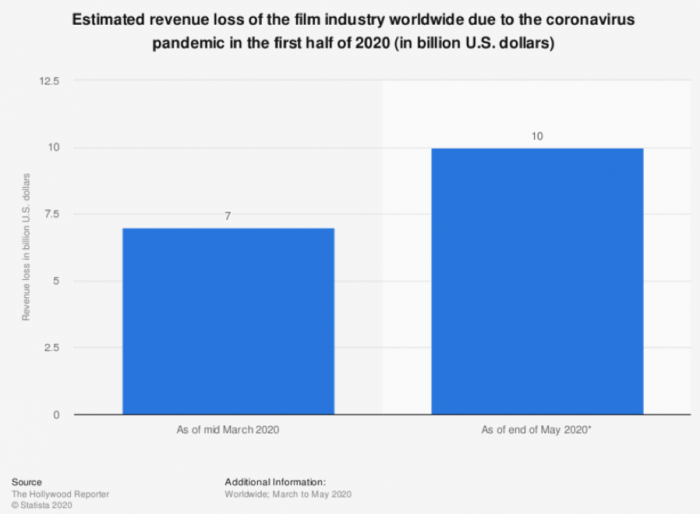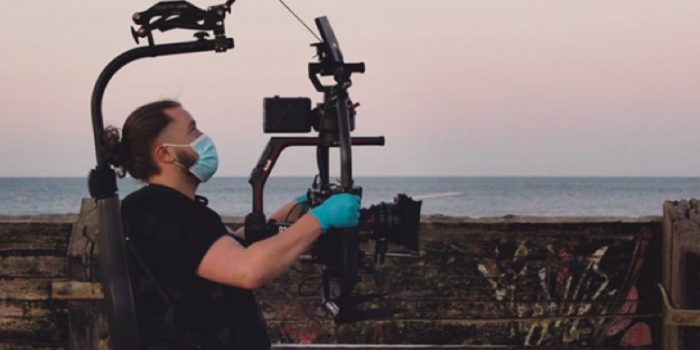No matter how much we could argue for the artistic value of the medium of film, or root for our favourite indie no-budget project to gain the recognition it deserves, the movie business is still, at the end of the day, a business. And just as the economic repercussions of COVID-19 have spread across pretty much every other industry on an unprecedented scale, the filmmaking sector is no different.
Despite the pre-COVID decline in cinema attendance, one could argue that it’s still quite a lucrative industry during normal times. Last year, for instance, global box office revenue reached an all-time high at $42 billion, while worldwide production and distribution as a whole was valued at an estimated $136 billion.
But how is this value affected when productions are put on hold, expensive safety measure have to be implemented, and the key, “traditional” exhibitors (aka cinemas) are still, for the most part, closed and going through times of great uncertainty? What’s the true scale of this phenomenon? How can one finance their projects these days, and what sort of projects are actually getting the funding they need?
Whether you’re an emerging content creator, a film professional or an industry connoisseur, here’s what you need to know about film financing in the COVID-19 era.

The Bad
Let’s start by going through how films are financed, which is usually, at least in the case of no-studio movies, a combination of public and private funding. Amidst a global pandemic, media funds and film grants were forced to change their schedules and parameters, and, in some cases, lower or close their funds. And while governments in countries such as Canada, the UK and France have come up with partial solutions and forms of support, models across the industry remain severely affected.
In the United States, private funding is the main financing route. In the case of medium and low budget films, this will often mean finance bonds, and, in many cases, these productions were the first to halt as insurance costs rapidly increased. Thus, at the moment, insurance and bonds have reshaped their policies and contracts, often excluding COVID-19 in much the way that other viral diseases like swine flu are habitually left out.
The moral and legal lines on who should be responsible for what are also blurry. In June, Deadline quoted one film exec as asking, “[W]hat’s going to happen if you have a $20 million movie and an actor become incapacitated?” They continued, “The liability is on the producer to cover the gap between $2 million and $20 million.”
The most affected groups? Freelance and self-employed crew and artists, as well as many small businesses working in the supply chain, such as kit suppliers, which are seeing massive losses of business as productions and venues shut down. But even working as a screenwriter – a field that’s proven perfectly amenable to social distancing measures – can be financially uncertain, since fees are often divided into several instalments, with the last and usually highest payment being linked to the first day of filming.

The Silver Lining
On the positive side, public and private entities were often quick to lend a hand to those more affected in the business. The partnership between BFI and the Film + TV Charity, for example, created a £2.5m industry-backed COVID-19 Emergency Relief Fund to help support the creative community via donations from a range of industry partners.
Meanwhile, as schedules and workflows are thrown into a state of disarray, passion has become a key motivator for cast and crew – not to mention financiers – when they look for their next project. Moreover, while new financial pressures will be felt across all kinds of movies, the effects generally won’t be as disruptive for the two “extremes” of production budgets.
On the one hand, big studios have different distribution channels, thus enabling them to adapt to the constantly changing circumstances. And on the other end of the spectrum, “guerrilla” filmmakers that were previously accustomed to filming quickly and cheaply will often be less affected by insurance schemes than those working with a bigger budget.

The Future
In most cases, going back to business as usual will not be an option for the foreseeable future. The extra health security and insurance costs created by COVID-19 have made movie financing riskier, while the new safety measures that sets are now adopting can increase production costs significantly.
While there are many different forecasts of the financial repercussions in the industry, what happens next remains uncertain, though that isn’t stopping producers from preparing themselves for the new world. The German Producers Alliance, for instance, is currently lobbying for a default fund to allow productions to continue as planned.
More generally, we know that consumer behaviour is rapidly evolving as the world adjusts to a new way of working, where social distancing, working from home and virtual meetings are the norm. As we’ve discussed in previous articles, this new environment has accelerated the rise of VOD platforms and home entertainment options as an alternative to theatres. The overall fear? That big streaming portals like Netflix and Amazon, having acquired a bigger share of the market during lockdown, will hold a monopoly on what we see and what gets made, and that truly independent content will get lost in the crowd.
At FilmDoo, we believe in helping these independent and original projects reach the audiences they deserve. That’s why we are now on the lookout for new and engaging films of all kinds to showcase online, be it on our own streaming platform, via our existing partners (including Amazon Prime Video and Vimeo on Demand), or for our new online edutainment tool, which allows students learn any subject through the medium of film.
Get in touch for more information!
If you’d like to learn more about the new production guidelines issued across Europe, check out the European Film Commissions Network’s list here. As for film funding help, BFI has gathered a list of tools for industry members and content owners alike, which you can check out here.
This article was published as part of an ongoing series on the impact and long-term effects of COVID-19 on the film industry. These posts have now been collated into a single, long-form article which you can read here.
Cover image: StudioBinder





